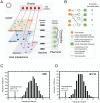Viral perturbations of host networks reflect disease etiology
- PMID: 22761553
- PMCID: PMC3386155
- DOI: 10.1371/journal.pcbi.1002531
Viral perturbations of host networks reflect disease etiology
Abstract
Many human diseases, arising from mutations of disease susceptibility genes (genetic diseases), are also associated with viral infections (virally implicated diseases), either in a directly causal manner or by indirect associations. Here we examine whether viral perturbations of host interactome may underlie such virally implicated disease relationships. Using as models two different human viruses, Epstein-Barr virus (EBV) and human papillomavirus (HPV), we find that host targets of viral proteins reside in network proximity to products of disease susceptibility genes. Expression changes in virally implicated disease tissues and comorbidity patterns cluster significantly in the network vicinity of viral targets. The topological proximity found between cellular targets of viral proteins and disease genes was exploited to uncover a novel pathway linking HPV to Fanconi anemia.
Conflict of interest statement
The authors have declared that no competing interests exist.
Figures



References
-
- IARC Monographs. Human Papillomaviruses. Lyon, France: International Agency for Research on Cancer; 2005. 670
-
- Kutok JL, Wang F. Spectrum of Epstein-Barr virus-associated diseases. Annu Rev Pathol. 2006;1:375–404. - PubMed
Publication types
MeSH terms
Substances
Grants and funding
LinkOut - more resources
Full Text Sources
Medical

